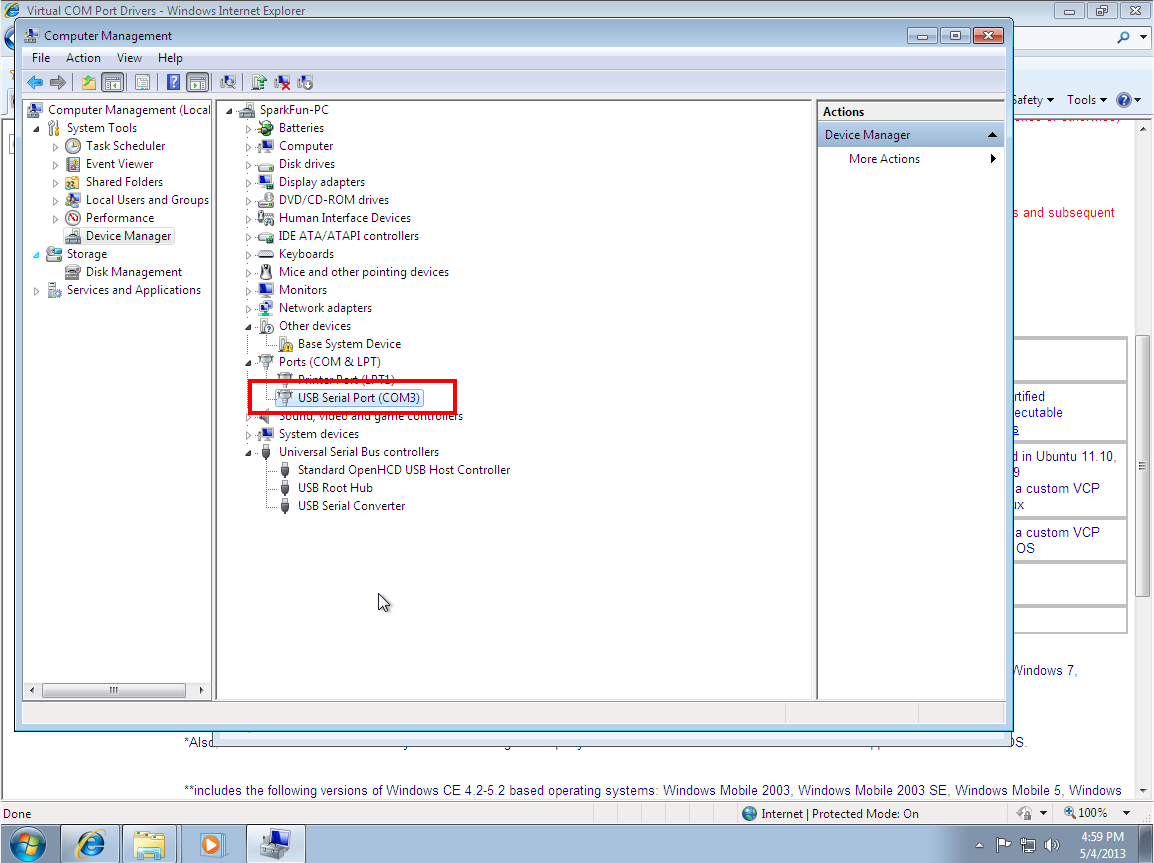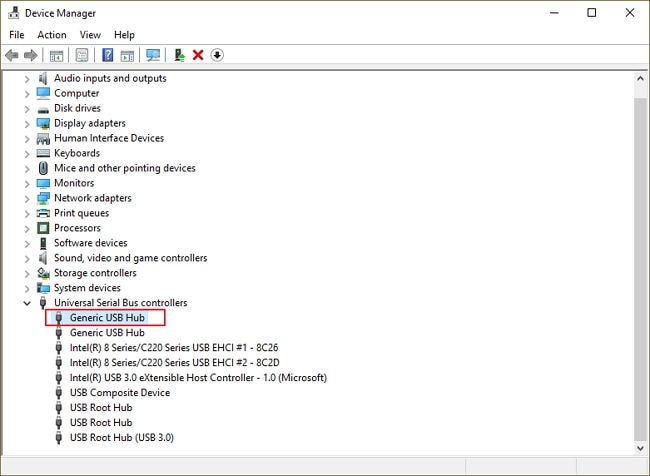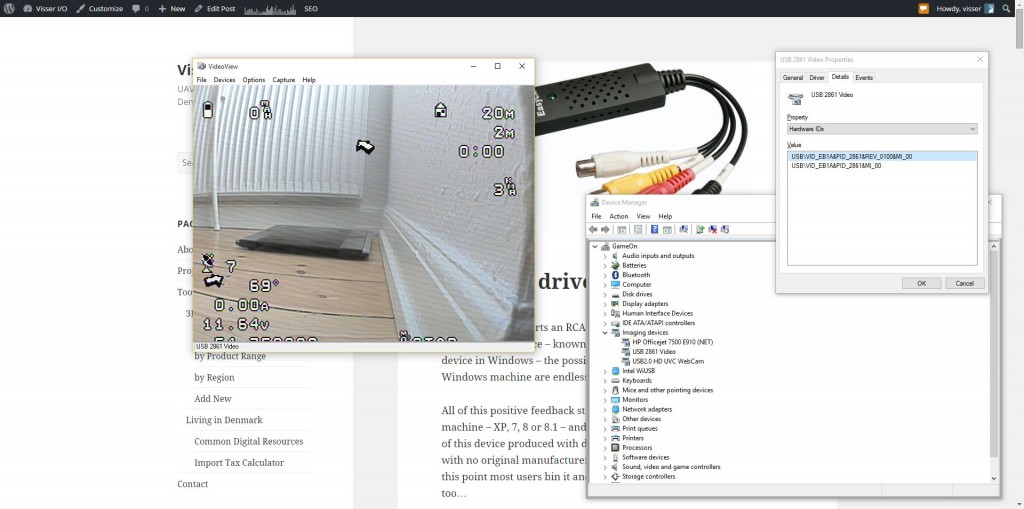Select LG Mobile Drivers and click Windows or Mac button to download LG Universal Mobile Drivers. Installing USB Driver. If your phone is connected to the USB Port of your PC, Disconnect it before running the installer you just downloaded. Click the downloaded.exe file. Select the language and click Next button to install LG Universal. THREE: IDENTIFY COM PORT USED BY THE USB DEVICE Once the device and driver are installed, confirm which COM port is being used by the USB device. You must know which COM port is being used in order to correctly set up applications that interact with the USB device. Use the following steps to identify the COM port. ELAN PS/2 Port Input Device Driver 15.7.9.2 for Windows 10 Anniversary Update 64-bit download - X 64-bit Download - x64-bit download - freeware, shareware and software downloads.
A Windows printer definition includes a port and device driver. For standard output devices, you can use port and device driver pairs supplied by Microsoft or a printer vendor. For output and input devices unique to the Barr software, you can use the port and device driver pairs supplied with BARR/SPOOL.
Different port and device driver pairs are used to direct data into and out of the spool. Which port and device driver combination you use in a particular instance depends on both the data source and the intended data destination. Drivers format data as it exits a program. Ports control the flow of data to its destination.
The port and device driver combination you use for a Windows printer for BARR/SPOOL depends on whether the Windows printer is a source or destination for spool files.
When you input files to the spool or output files from the spool, you must use port and device driver pairs that correspond to the file format. The original file will be in one of two types of file formats: Barr formats or printer-specific formats.
Files in a Barr format require a Barr port and a Barr device driver. Examples of files in a Barr format include files sent with Print Utility or files input from an NJE host with the BARR/NJE module.
Examples of files in a printer-specific format include files from a Windows program such as Microsoft Word. Files in a printer-specific or destination-ready Data formatted for its ultimate destination. For example, if the data is intended for a printer, it becomes destination-ready when it gets converted to the format the intended printer requires. format require a port and device driver from the printer manufacturer.
When you use a printer-specific driver on inbound spool data, the file is converted only once (instead of twice), which speeds overall processing.
The following links provide descriptions of the available ports and examples of their use.
What do you want to do?
See also:
Port and device driver descriptions
The following tables list the available ports and device drivers, along with a description. The port and device driver combination you choose depends on both the data source and the intended data destination.
Ports
Option | Description |
Barr File port | Use only for spool output to computer disk destinations. |
Barr FTP port | Use only for spool output to an FTP host. |
Barr IP port | Use only for spool output to a TCP/IP socket or a Xerox DocuPrint EPS Acronym for Enterprise Printing System.. |
Barr LPR port | Use only for spool output, to route ASCII files to a TCP/IP LPD host. |
Barr NJE port | Use only for spool input to an NJE host. |
Barr PRINT390 port | Use only for spool output to S/390 channel output devices, such as S/390 channel printers. |
Barr RJE port | Use only for spool output to an RJE host. |
Barr Spool port | Use only for spool input from Windows programs. |
Local port (LPT1, COM1) | Use for output to local or network printers. |
Device drivers
Option | Description |
Barr ASCII printer driver | Use for spool output to legacy ASCII line printers. |
Barr EBCDIC printer driver | Use for spool input from Windows programs. |
Barr Jobs to Mainframe printer driver | Use for spool input intended for hosts and for spool output to hosts. |
Barr PRINT390 printer driver | Use for spool output to S/390 channel printers. |
Printer-specific driver | Use for spool input or output. |
Port and device driver examples
These examples list which port and device drivers you would use to define Windows printers for spool input and output for a specified file format, source, and destination.
Text file to PC-attached channel printer
Receive a text file from a Windows program and print to a channel printer.
Barr EBCDIC printer driver & Barr Spool port Spool
Barr PRINT390 printer driver & Barr PRINT390 port Channel device

Text file to local parallel printer
Receive a text file from a Windows program and print to a network printer.
Barr EBCDIC printer driver & Barr Spool port Spool
HP printer driver & network HP port LPT device
Text file to host (SYSIN)
Receive a JCL text file from a Windows program and send it to the host as a SYSIN job.
When SYSIN jobs are added to the Spool Window, they appear shaded in a light blue background.
For BARR/NJE

Barr Jobs to Mainframe printer driver & Barr Spool port Spool
Barr Jobs to Mainframe printer driver & Barr NJE port Host
For BARR/RJE
Barr Jobs to Mainframe printer driver & Barr Spool port Spool
Barr Jobs to Mainframe printer driver & Barr RJE port Host
Text file to host (SYSOUT)
Receive a text file from a Windows program and use BARR/NJE to send it to the host as a SYSOUT job.
BARR/RJE does not support sending SYSOUT data to the host.
Barr EBCDIC printer driver & Barr Spool port Spool
Barr Jobs to Mainframe printer driver & Barr NJE port Host
Native printer format (pass through) to network printer
Receive a raw file from a Windows program and send it to a network printer.
HPII driver & Barr Spool port Spool
Network HP LaserJet printer LPT device
Text file from Print Utility to local parallel printer
Use Print Utility to send a text file and print it to a parallel printer.
Network HP LaserJet printer LPT device
EBCDIC file from host to channel printer
Receive an EBCDIC file from an NJE host and print it to a channel printer.
Barr PRINT390 printer driver & Barr PRINT390 port Channel device
EBCDIC file from host to a client application
Receive an EBCDIC file with Print Channel from host and send it to a client application.
Barr ASCII driver & Barr IP port TCP/IP socket
This article describes an issue that occurs when you use a FireWire port-based device in Windows 8.1 or Windows 8. Additional steps of configuration is required to enable this update after the installation.
Symptoms
Assume that you have a computer that equips with an IEEE 1394 FireWire controller card. After you upgrade the computer from Windows 7 to Windows 8.1 or Windows 8, devices that connect to the computer by using a FireWire port do not work.
Cause
This issue occurs because the legacy 1394 bus drivers (1394bus.sys and Ochi1394.sys) are removed in Windows 8.1 or Windows 8.
Resolution
Update information
How to obtain this update
Microsoft Download Center
The following files are available for download from the Microsoft Download Center:
Operating system | Update |
|---|---|
All supported x86-based versions of Windows 8.1 or of Windows 8 | |
All supported x64-based versions of Windows 8.1 or of Windows 8 |
For more information about how to download Microsoft support files, click the following article number to view the article in the Microsoft Knowledge Base:
119591 How to obtain Microsoft support files from online services Microsoft scanned this file for viruses. Microsoft used the most current virus-detection software that was available on the date that the file was posted. The file is stored on security-enhanced servers that help prevent any unauthorized changes to the file.
Additional steps of configuration requirement
After you install the 1394 OHCI Legacy Driver.msi file, follow these steps:
Right-click the Legacy1394.inf file under one of the following paths based on the computer's architecture:
C:Program Files1394 OHCI Compliant Host Controller (Legacy)x86_driver
C:Program Files1394 OHCI Compliant Host Controller (Legacy)x64_driver
Click Install.
Open Device Manager in Control Panel.
Expand IEEE 1394 Bus host controllers, and then locate the host controller.
Right-click the host controller, and then click Update Driver Software.
The screen shot of the host controller and the Update Driver Software is listed in the following example:Click Browse my computer for driver software.
Click Let me pick from a list of device drivers on my computer.
Click Generic1394 OHCI compliant host controller (Legacy), and then click the Next button.
Click the Close button.
Prerequisites
There are no prerequisites for installing this update.
Registry information
To apply this update, you do not have to make any changes to the registry.
Restart requirement
You have to restart the computer after you apply this update.
Update replacement information
This update does not replace a previously released update.
File information
The global version of this hotfix installs files that have the attributes that are listed in the following tables. The dates and the times for these files are listed in Coordinated Universal Time (UTC). The dates and the times for these files on your local computer are displayed in your local time together with your current daylight saving time (DST) bias. Additionally, the dates and the times may change when you perform certain operations on the files.
Windows 8.1 and Windows 8 file information notesThe MANIFEST files (.manifest) and the MUM files (.mum) that are installed for each environment are not listed
For all supported x86-based versions of Windows 8.1 or of Windows 8
File name | File version | File size | Date | Time | Platform |
|---|---|---|---|---|---|
1394_ohci_legacydriver.msi | Not Applicable | 208,896 | 15-Aug-2014 | 20:48 | Not Applicable |

For all supported x86-based versions of Windows 8.1 or of Windows 8
File name | File version | File size | Date | Time | Platform |
|---|---|---|---|---|---|
1394_ohci_legacydriver.msi | Not Applicable | 208,896 | 15-Aug-2014 | 20:48 | Not Applicable |
Status
E-mon Port Devices Drivers
Microsoft has confirmed that this is a problem in the Microsoft products that are listed in the 'Applies to' section.
More Information
Steps of uninstalling the 1394 OHCI Legacy Driver.msi file
Open Control Panel in the Category view.
Click Uninstall a program in Control Panel.
Right-click 1394 OHCI Compliant Host Controller (Legacy), and then click Uninstall.
The screen shot of uninstalling the 1394 OHCI Compliant Host Controller (Legacy) is listed in the following example:
Additional package information
This driver is only intended to work with legacy 1394 host controllers. Therefore, you may experience lower transfer data rates than the 1394b driver.
The driver is intended to resolve compatibility issues for 1394 peripherals on 1394b systems. If you are not experiencing these issues, you should continue to use inbox drivers that are provided in Windows 8.1 or Windows 8.
You have to reinstall this stand-alone driver package if you upgrade to a newer operating system version in the future.
For more information about software update terminology, click the following article number to view the article in the Microsoft Knowledge Base:
E-mon Port Devices Driver Updater
824684 Description of the standard terminology that is used to describe Microsoft software updates
